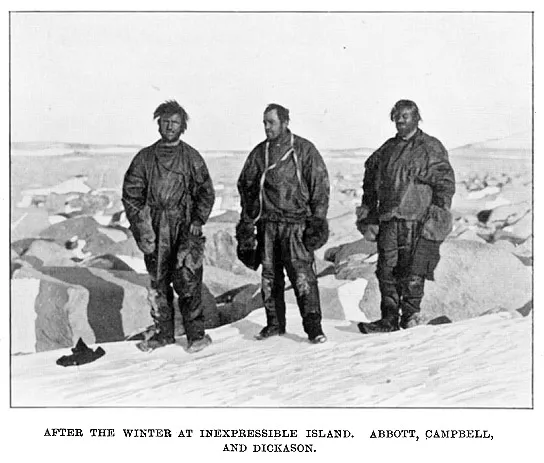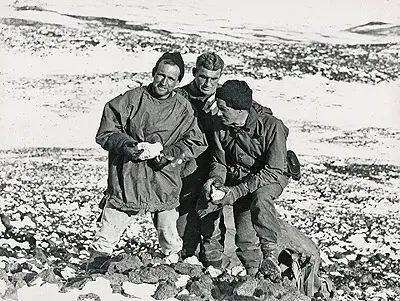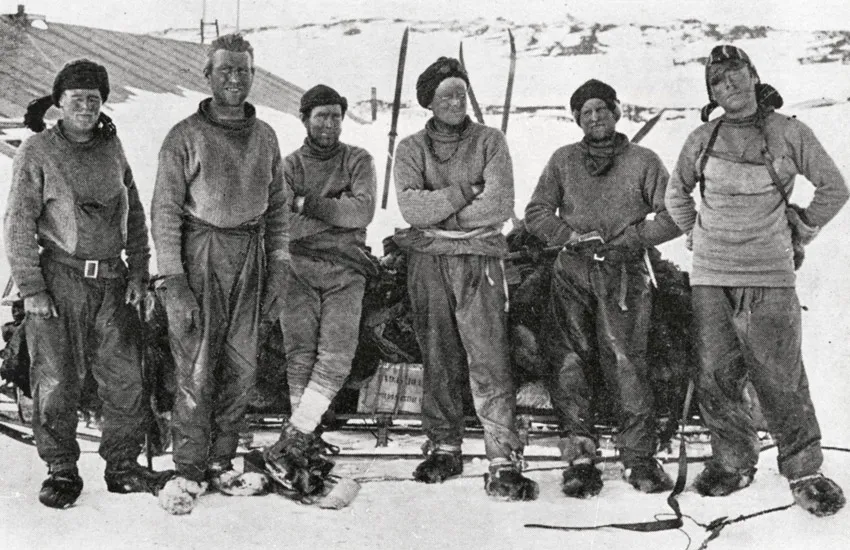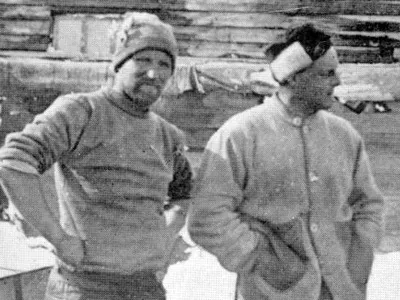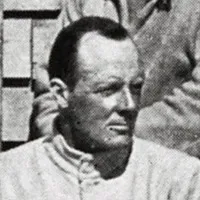
Campbell, Victor Lindsay Arbuthnot - Lieutenant
(1875
- 1956)
Biographical notes
First Officer - Lieutenant, R.N. - Terra Nova 1910-13
Victor Campbell
20th August 1875 - 19th November 1956
Born in Brighton, England, and educated at Eton, Victor Campbell served initially in the merchant navy before receiving a Royal Navy commission in 1895. He resigned this in 1901 and lived the life of a country gentleman before joining Scott on the Terra Nova. Having private means he spent many summers in Norway where he learned to become proficient on skis and learned much about glacier, mountains and snow. He was nicknamed the "Wicked Mate" on board the ship as he was so keen on cleanliness.
He led what was to be an Eastern Party of 6 men to carry out scientific work in King Edward VII's Land at the far side of the Great Ice Barrier (now the Ross Ice Shelf) from Ross Island in the west. Unable to find a landing site, they proceeded westward again when the ship met Roald Amundsen and the Fram in the Bay of Whales. They continued back the way they had come via Cape Evans, eventually heading north when they built a hut and wintered at Cape Adare in 1911, from this point, they became known as the "Northern Party".
They wintered successfully though were unable to travel far or find a place where they could readily strike inland. So in January 1912 they were transferred about 250 miles further south by the Terra Nova to Evans Cove to carry out a geological survey. They had enough sledging rations for 6 weeks and the intention of staying 2 weeks before being picked up again. Sea ice conditions meant that the ship could not reach them and they had to over-winter again. An ice cave was excavated on what they named Inexpressible Island and a miserable winter ensued, rations being extended with the occasional seal or penguin that could be killed.
With no relief forthcoming and not even sure if the Terra Nova had been lost or not after they weren't picked up the previous summer as planned, the six men decided to start the 200 mile walk back to base at the end of winter on the 30th of September 1912. They were in a very weakened state with barely enough food and insufficient equipment but fortunately found a food and fuel depot along with the news that the Terra Nova had not been lost, they arrived at Cape Evans on the 7th of November in much better condition due to their new found supplies than they had been after their awful winter. Their journey should been around 55 weeks, in the end they were gone for 93 weeks.
Campbell assumed command of the Terra Nova after being told of the death of Scott and the Polar Party as he was the senior remaining naval officer.
Campbell was decorated for his part in the WW1, rose to the rank of Captain and was awarded the OBE, he migrated to Newfoundland in 1922 where he farmed and fished, he died in 1956.
References to Victor Campbell by Cherry-Garrard in "The Worst Journey in the World"
-
Lieutenant Evans ........... was in charge of the ship, and did much to cement together the rough material into a nucleus which was capable of standing without any friction the strains of nearly three years of crowded, isolated and difficult life, ably seconded by Victor Campbell, first officer, commonly called The Mate, in whose hands the routine and discipline of the ship was most efficiently maintained. I was very frightened of Campbell.
-
Among the executive officers Scott was putting more and more trust in Campbell, who was to lead the Northern Party. He was showing those characteristics which enabled him to bring his small party safely through one of the hardest winters that men have ever survived.
-
Campbell and his five companions were finally landed at Cape Adare, and built their hut close to Borchgrevinck's old winter quarters. The ship returned to New Zealand under Pennell: came back to the Antarctic a year later with further equipment and provisions, and again two years later to bring back to civilization the survivors of the expedition.
-
I was waked at seven o'clock this morning by Levick demanding the loan of my camera. It appears that Amundsen, Johansen and six men had arrived at the Fram this morning at about 6.30 a.m., and had come over to interview Campbell and Pennell. Campbell, Pennell and Levick then went back to breakfast with them and stayed until nearly noon when they returned telling us to expect Amundsen, Nilsen, the first lieutenant of the Fram who is taking her back after landing the party, and a young lieutenant whose name none of us caught, to lunch. After lunch a party of officers and men went to see the rest of the Norwegians, see over the ship, and say good-bye.
Priestley's diary -
We must now go back to the six men led by Campbell who were landed at Cape Adare in the beginning of 1911. They were much disappointed by the small amount of sledge work which they were able to do in the summer of 1911-1912, for the sea-ice in front of them was blown out early in the year, and they were unable to find a way up through the mountains behind them on to the plateau. Therefore, when the Terra Nova appeared on January 4, it was decided that she should land them with six weeks' sledging rations and some extra biscuits, pemmican and general food near Mount Melbourne at Evans Coves, some 250 geographical miles south of Cape Adare, and some 200 geographical miles from our Winter Quarters at Cape Evans. Late on the night of January 8, 1912, they were camped in this spot and saw the last of the ship steaming out of the bay. They had arranged to be picked up again on February 18.
-
The serious part of the news was that owing to a heavy pack the ship had been absolutely unable to reach Campbell's party at Evans Coves. Attempt after attempt had made without success. Would Campbell winter where he was? Would he try to sledge down the coast?
-
As time went on anxiety concerning the non-arrival of the Polar Party was added to the alarm we already felt about Campbell and his men; winter was fast closing down, and the weather was bad.
-
The second attempt was then made, and this consisted of a party of four men who tried to sledge up the Western Coast in order to meet and help Campbell if he was trying to sledge to us. This plucky attempt failed, as indeed it was practically certain it would.
-
Meanwhile the stranded men divided into two parties of three men each. The first under Campbell sank a shaft six feet down into a large snow-drift and thence, with pick and shovel, excavated a passage and at the end of it a cave, twelve feet by nine feet, and five feet six inches high.
-
As we neared the Cape Atkinson turned to me: "Would you go for Campbell or the Polar Party next year?" he said. "Campbell," I answered: just then it seemed to me unthinkable that we should leave live men to search for those who were dead.
-
If we started in the end of October to relieve Campbell, estimating the probable date of arrival of the ship, we judged that we could reach him only five or six weeks before the ship relieved him. All the same Campbell and his men might be alive, and, having lived through the winter, the arrival of help might make the difference between life and death.
-
It was with all this in our minds that we sat down one evening in the hut to decide what was to be done. The problem was a hard one. On the one hand we might go south, fail entirely to find any trace of the Polar Party, and while we were fruitlessly travelling all the summer Campbell's men might die for want of help. On the other hand we might go north, to find that Campbell's men were safe, and as a consequence the fate of the Polar Party and the result of their efforts might remain for ever unknown. Were we to forsake men who might be alive to look for those whom we knew were dead?
-
We came in 24 miles with our loads, to find the best possible news - Campbell's Party, all well, are at Cape Evans. They arrived here on November 6, starting from Evans Coves on September 30. What a relief it is, and how different things seem now! It is the first real bit of good news since February last - it seems an age. We mean to get over the sea-ice, if possible, as soon as we can, and then we shall hear their story.
-
Campbell and his men, unaided, had not only survived their terrible winter, but had sledged down the coast after it. We ourselves, faced by a difficult alternative, had fallen on our feet. We never hoped for more than this: we seldom hoped for so much.
-
Their stove was the bottom of an oil tin, and they cooked by dripping blubber on to seal bones, which became soaked with the blubber, and Campbell tells me they cooked almost as quickly as a primus. Of course they were filthy. Their main difficulty was dysentery and ptomaine poisoning.
-
Our next job was to pick up the geological specimens at Evans Coves, where Campbell and his men had wintered in the igloo, and also to leave a depot there for future explorers.
References to Victor Campbell by Scott in "Scott's Last Expedition"
-
Soon after Campbell and Day arrived to confirm the dismal tidings. It appears that getting frightened of the state of affairs Campbell got out a line and attached it to the motor - then manning the line well he attempted to rush the machine across the weak place. A man on the rope, Wilkinson, suddenly went through to the shoulders, but was immediately hauled out. During the operation the ice under the motor was seen to give, and suddenly it and the motor disappeared. The men kept hold of the rope, but it cut through the ice towards them with an ever increasing strain, obliging one after another to let go. Half a minute later nothing remained but a big hole. Perhaps it was lucky there was no accident to the men, but it's a sad incident for us in any case. It's a big blow to know that one of the two best motors, on which so much time and trouble have been spent, now lies at the bottom of the sea. The actual spot where the motor disappeared was crossed by its fellow motor with a very heavy load as well as by myself with heavy ponies only yesterday.
Landmarks named after Victor Campbell
Feature Name: Campbell Glacier and Campbell Glacier Tongue
Type: Glacier
Latitude: 74°25'00S
Longitude: 164°22'00E
Description: A glacier, about 60 mi long, originating near the S end of Mesa Range and draining SE between Deep Freeze Range and Mount Melbourne to discharge into N Terra Nova Bay. The lower end of the glacier was observed by the Northern Party, led by Lieutenant Victor L.A. Campbell, Royal Navy (RN), of the British Antarctic Expedition (BrAE), 1910-13. The extent of the glacier and its discharge into N Terra Nova Bay, rather than the Nansen Ice Sheet.
Other Crew of the Terra Nova Expedition
Abbot,
George Percy - Petty Officer, R.N. - 1, 2, N
Atkinson, Edward
L. - R.N. - surgeon, parasitologist - 1, 2, D, P, S
Balson,
Albert - Leading seaman, R.N.- 1, 2
Bowers,
Henry Robertson - Lieutenant - 1, 2, D, C,
Po
Browning,
Frank Vernon - Petty Officer - 1, 2, N
Campbell,
Victor - Lieutenant, R.N. - 1, 2, N
Cheetham,
Alfred B. - Boatswain (Bosun), R.N.R.
Cherry-Garrard,
Apsley - Assistant zoologist - 1, 2, D, C, S
Crean,
Tom - petty officer, R.N. - 1, 2, D, P, S
Debenham, Frank
- Geologist - 1, 2, iW, iiW
Dickason,
Harry - Able Seaman - 1, 2, N
Evans, Edgar - petty
officer, R.N. - 1, iW, Po
Evans, Edward R.G.R. - Lieutenant, R.N. "Teddy Evans" -
second in command, and Captain of the Terra Nova - 1, D, P
Girev
(Geroff), Dmitriy - Dog driver - 1, 2, D, P, S
Gran,
Tryggve - ski expert - 1, 2, D, iiW, S
Lashly, William
- chief stoker, R.N. - 1, 2, P, S
Levick,
G. Murray - Surgeon, R.N. - 1, 2, N
Lillie, Dennis Gascoigne - Biologist
on the ship
McLeod, Thomas
F. - Able seaman - 1, 2
Meares, Cecil
H. - in charge of dogs - 1, D, P
Oates, Lawrence
- Capt. 6th Iniskilling Dragoons - 1, D,
Po
Ponting,
Herbert G. - Camera artist - 1
Priestley,
Raymond E. - Geologist - 1, 2, N
Omelchenko,
Anton - Groom - 1
Scott, Robert
Falcon - Commander, R.N. -
Expedition leader - 1, D, Po
Simpson,
George - Meteorologist - 1
Taylor,
T. Griffith - Geologist - 1, iW, iiW
Wilson,
Edward Adrian - chief of scientific staff and biologist - 1, D, C,
Po
Wright,
Charles Seymour - Physicist - 1, 2, iW, P, S
Key:
1 - first winter
2 - second winter
iW - first western party
iiW - second western party
N - northern
party
D - depot laying for south pole journey
P - south pole party
C - winter journey to Cape Crozier
S - search party for south Pole
party
Po - reached
South Pole
Biographical information
- I am concentrating on the Polar experiences of the men involved.
Any further information or pictures visitors may have will be gratefully received.
Please email
- Paul Ward, webmaster.
What are the chances that my ancestor was an unsung part of the Heroic Age
of Antarctic Exploration?

